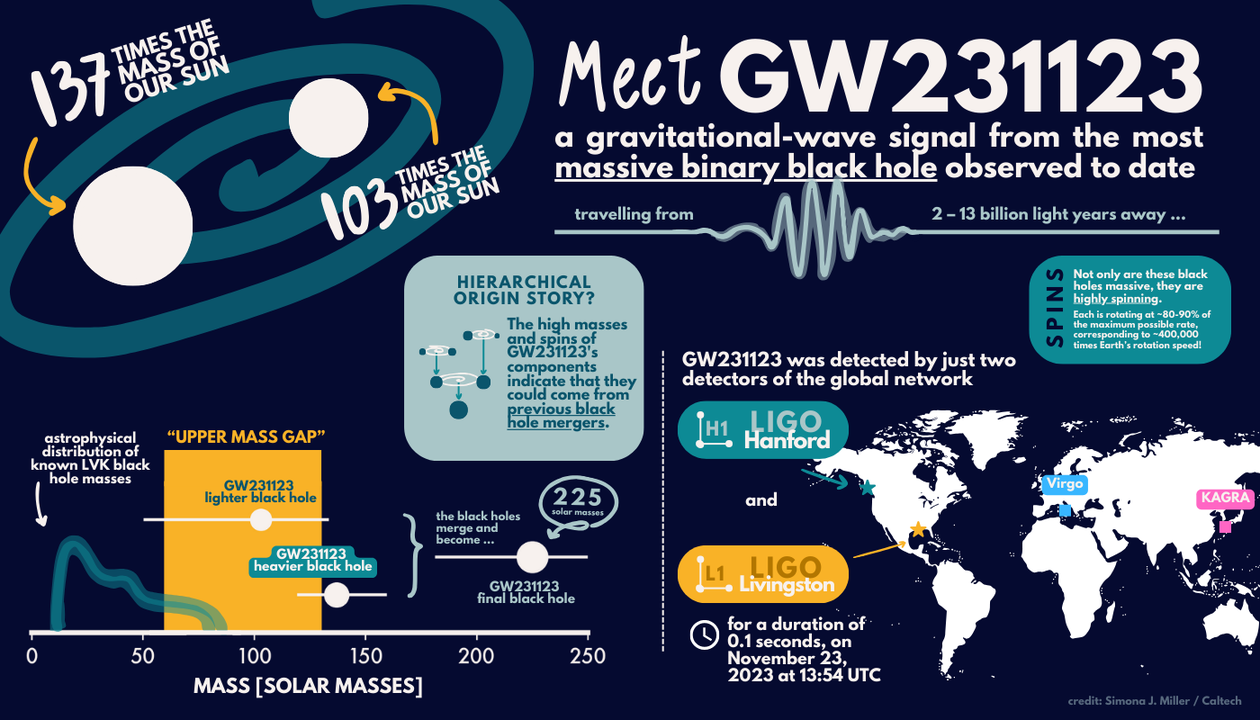Astronomy Object of the Month: 2025, July
< previous Archive next >
The most massive Black Hole Binary detected through gravitational waves
On November 23, 2023, the LIGO-Virgo-KAGRA (LVK) collaboration detected GW231123, a gravitational-wave signal likely caused by the merger of two black holes with the highest combined mass the LVK collaboration has ever observed. These black holes would have been spinning incredibly fast, and their individual masses appear to fall into a range that challenges existing theories about how massive stars evolve and end their lives.

Illustration (1): Visualization of the merger of two black holes, generated using AI (ChatGPT/DALL·E, OpenAI).
The black hole system
The two merging black holes had masses approximately 100 and 140 times greater than the mass of the Sun, respectively. In addition to their large mass, they also rotated rapidly, which made the signal emitted by the system extremely difficult to interpret and suggested the possibility of a complex formation history for this system. The discovery of such a massive and rapidly rotating system is not only a challenge for our data analysis techniques, but also has enormous implications for future theoretical research into black hole formation channels and the modeling of gravitational waves. In fact, current models of stellar evolution do not allow for the existence of such massive black holes. Such black holes may have formed as a result of earlier mergers of smaller black holes.To date, the LVK consortium has published the results of gravitational wave detection from approximately 100 black hole mergers. The binary system with the largest mass to date was the source of the GW190521 signal, with a total mass “only” 140 times greater than the mass of the Sun.
The limits of gravitational wave astronomy
The large mass and extremely fast rotation of black holes in GW231123 push the boundaries of both gravitational wave detection technology and our current theoretical models. For the analysis of the present case, extracting accurate information from the signal called for the use of theoretical models taking into account the complex dynamics of rapidly rotating black holes. All of this stretches our capabilities in terms of instruments and data analysis to the limits of what is currently possible. It is also a powerful example of how much we can learn from gravitational wave astronomy, and how much more there is still to discover.Gravitational wave detectors such as LIGO in the United States, Virgo in Italy, and KAGRA in Japan are designed to measure subtle oscillations in spacetime caused by violent cosmic events such as the merger of black holes. The fourth LVK observation campaign began in May 2023, and observations from the first half of the campaign (until January 2024) will be published in late summer this year.
LIGO-Virgo-KAGRA Collaboration
The LIGO project is funded by the US National Science Foundation (NSF) and managed by Caltech and MIT, which developed and implemented the project. Financial support for the Advanced LIGO project was provided by the National Science Foundation (NSF), with significant contributions from Germany (Max Planck Society), the United Kingdom (Engineering and Physical Sciences Research Council), and Australia (Australian Research Council). More than 1,600 scientists from around the world participate in the project through the LIGO Scientific Collaboration, of which the GEO Collaboration is a part.Virgo Collaboration currently has approximately 1,000 members from 175 institutions in 20 different countries (mainly European), including scientists from Poland, members of the Virgo-Polgraw team. The participants of the VIRGO experiment from the Jagiellonian University in Cracow are prof. M. Ostrowski, Eng. J. Kubisz, dr hab. Ł. Stawarz and dr hab. Zenon Nieckarz.
The research we are conducting as part of the Virgo collaboration, comments Prof. Ostrowski, head of the team from the Jagiellonian University, involves monitoring and studying extremely low-frequency electromagnetic waves propagating around the Earth, which could interfere with the ultra-precise measurements of gravitational wave detectors.
The European Gravitational Observatory (EGO) operates the Virgo detector near Pisa, Italy, and is funded by the Centre National de la Recherche Scientifique (CNRS) in France, the National Institute for Nuclear Physics (INFN) in Italy, the National Institute for Subatomic Physics (Nikhef) in the Netherlands, the Research Foundation – Flanders (FWO), the Belgian Research Foundation (F.R.S.–FNRS), and the Polish Ministry of Science and Higher Education.
The list of groups forming the Virgo Collaboration can be found at this website. Further information on the Virgo project website.

Illustration (2): Infographic – merger of black holes GW231123 (LIGO Scientific Collaboration).
Original publication: The LIGO Scientific Collaboration, the Virgo Collaboration, the KAGRA Collaboration, GW231123: a Binary Black Hole Merger with Total Mass 190-265 MSun, LSC P&P Committee, July (2025).
The research described is part of the research topics conducted at the Department of High Energy Astrophysics of Astronomical Observatory of the Jagiellonian University in Kraków.
|
Łukasz Stawarz Astronomical Observatory Jagiellonian University Lukasz.1.Stawarz [at] uj.edu.pl |


